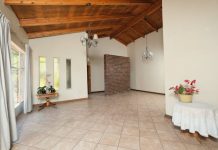Looking to make your kitchen work better for your everyday activities?
A kitchen remodeling project goes beyond creating visual appeal because it aims to design a space that supports daily functioning. Current statistics reveal that homeowners now allocate more funds than previously recorded towards kitchen upgrades for both aesthetic appeal and practical use with typical remodel expenses reaching $60,000.
This guide will teach you how to enhance your kitchen renovation project by achieving maximum functionality and value.
What’s Coming Up:
- Understanding Kitchen Remodel Investment Trends
- Key Functional Design Elements
- Professional Support for Your Project
- Smart Storage Solutions
- Modern Kitchen Layout Options
- Technology Integration Tips
- Lighting Strategies for Functionality
Understanding Kitchen Remodel Investment Trends
The kitchen remodeling landscape is evolving rapidly. Major renovations for large kitchens with 250 square feet or more now require $72,000 which represents a 9% investment increase while minor kitchen updates have risen by 75% to reach $35,000. Homeowners in the 90th financial percentile have escalated their major kitchen remodeling budgets to at least $180,000.
But here’s what’s really interesting…
During renovation projects homeowners decide to enlarge their kitchen areas 35% of the time. Homeowners find new ways to expand their kitchens by transforming existing spaces such as dining rooms (29%) and living rooms (12%) and constructing home additions (18%).
Key Functional Design Elements
Your Plymouth kitchen remodel should prioritize functional design elements to achieve success. Successful kitchen renovations merge practical workspace layouts with modern conveniences that simplify cooking and entertaining activities.
Consider these essential functional elements:
- Arrange your kitchen layout to create efficient working distances between your sink, stove and refrigerator.
- Integrate counters with different heights to accommodate various kitchen tasks.
- Maintain sufficient counter space next to essential appliances to create adequate landing zones.
- Make storage more accessible by adding pull-out shelves and deep drawers to your kitchen.
- The kitchen should have separate designated areas for cooking activities, food preparation tasks, and cleaning processes.
The combination of these elements results in a kitchen design which provides aesthetic appeal and perfect functionality for everyday activities.
Professional Support for Your Project
Here’s something crucial to consider…
A successful kitchen remodel requires professional expertise. The latest data indicates that 86% of homeowners seek professional assistance for kitchen remodeling projects. General contractors lead as the most preferred experts at 50%, kitchen designers come in second at 25%, followed by architects at 13%, design-build professionals at 12%, and kitchen remodelers at 8%.
Why such high reliance on professionals? Because they bring:
- Technical expertise for complex installations
- Knowledge of building codes and permits
- Access to quality materials and suppliers
- Project management experience
- Problem-solving skills for unexpected issues
Experienced professionals help prevent expensive errors and make sure your kitchen redesign achieves both practicality and style.
Smart Storage Solutions
What do you think has transformed kitchen functionality the most?
It’s all about smart storage solutions. Today’s kitchen design trends replace conventional cabinets with fresh storage solutions which utilize every available space. Here’s what’s trending:
- Two-sided pull-out pantry systems allow easy access to items from both sides of the cabinet.
- Deep drawer organizers provide storage solutions for pots, pans, and small appliances.
- Vertical storage dividers enable efficient organization of baking sheets and cutting boards.
- Corner cabinet solutions include lazy Susans together with pull-out shelving options.
- Specific areas reserved for small appliances now include power outlets.
But here’s the real secret…
The most functional kitchens incorporate multiple storage solutions tailored to your specific requirements. Prioritize placing the items you use most frequently within easy reach of your main work areas.
Modern Kitchen Layout Options
Your kitchen layout determines whether your space will function effectively or not. Homeowners who are remodeling their kitchens show a strong preference for changing their kitchen layout since 53% of them want to do so with L-shaped and U-shaped plans being top choices at 37% and 33%.
Here’s what makes these layouts so effective:
- L-shaped kitchens combine spacious openness with practical efficiency.
- U-shaped designs maximize storage and counter space
- Island configurations add versatile workspace and seating
- Galley layouts work well in narrow spaces
- In compact kitchens peninsula layouts deliver similar advantages to those provided by islands
Choosing the right kitchen layout requires matching your space limitations with your actual cooking habits. Consider the movement patterns through your kitchen alongside designated work areas and the spots where you spend most of your cooking time.
Technology Integration Tips
Here’s something that’s revolutionizing modern kitchens…
Kitchen remodels now require smart technology integration as a standard feature. Applying the correct technology solutions can make your kitchen operate at optimal efficiency while simplifying both cooking tasks and cleaning routines. Consider incorporating:
- Smart faucets with touchless operation
- Under-cabinet lighting with motion sensors
- Voice-controlled appliances and timers
- Built-in charging stations for devices
- Smart refrigerators with inventory management
But remember this important point…
Technology additions to your kitchen must have a functional benefit. Select kitchen features that enhance your everyday routine instead of incorporating technology that doesn’t serve a practical use.
Lighting Strategies for Maximum Function
How can you quickly enhance your kitchen’s functional performance?
A well-lit kitchen helps keep your cooking space both safe and efficient. An effective lighting scheme merges multiple lighting types to produce both functional utility and welcoming atmosphere. Here’s how to layer your lighting effectively:
- Food preparation areas should incorporate under-cabinet lights to enhance task visibility.
- The main source of ambient light comes from fixtures installed into the ceiling which provide comprehensive illumination.
- Accent lighting should feature pendant lights positioned above kitchen islands or dining spaces.
- Natural lighting: Windows and skylights positioned strategically
- Dimmable options provide lighting that adjusts to fit different times of day.
But here’s what many people overlook…
Placement of lighting fixtures needs to be balanced with their color temperature. For enhanced visibility use cooler lighting (4000K-5000K) in prep areas while warmer lighting (2700K-3000K) creates comfortable dining spaces.
Maximizing Your Return on Investment
Potential financial benefits should guide your choice of kitchen upgrades during remodeling projects. The top reasons for kitchen renovations include: The top motivations for kitchen remodels are style updates at 35%, rectifying deterioration or dysfunction at 35%, financial readiness at 33%, personalization at 28%, and resale value enhancement at 25%.
Here’s what really matters…
Opt for enhancements that improve both aesthetic appeal and practical utility. This means:
- Choosing durable, timeless materials
- Installing energy-efficient appliances
- Design spaces that can adjust to serve multiple functions.
- Planning for future technological upgrades
- It’s essential to integrate design features that include contemporary trends while preserving classic styles.
Your selections should ensure longevity while fulfilling your current practical requirements.
Planning for Success
Numerous homeowners overlook a vital consideration during remodeling.
Your kitchen remodel will succeed if you follow a thorough planning and preparation process. Develop a comprehensive plan with all necessary details before beginning any work.
- A realistic budget with contingency funds
- A timeline for different phases of work
- Temporary kitchen arrangements during renovation
- Clear communication channels with contractors
- Develop an itemized list of essential features and additional desirable items.
But there’s more to consider…
Make sure to plan for the unexpected. Kitchen remodeling projects frequently reveal concealed plumbing and electrical issues that require resolution. It is crucial to maintain a contingency fund between 10-20% of your total budget to effectively manage unexpected issues while keeping your main functional objectives intact.
Final Thoughts: Your Dream Kitchen Awaits
A functional kitchen remodel involves more than just selecting new appliances and cabinets. Your kitchen should operate smoothly according to your particular requirements and simultaneously enhance your property’s value. Remember these key points:
- Establish your project with a thorough plan and feasible budget expectations.
- Prioritize functional improvements over purely aesthetic changes
- Collaborate with skilled experts who fully grasp your design objectives
- Choose materials and features that will last
- Consider future needs and technological advances
Investing in functional kitchen features results in long-term benefits that enhance your daily cooking, cleaning and hosting experiences. Focusing equally on form and function allows you to design a kitchen that excels both visually and operationally.
Ready to start your kitchen transformation?





